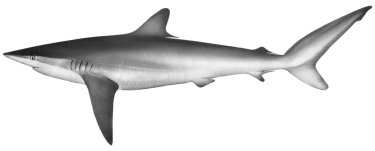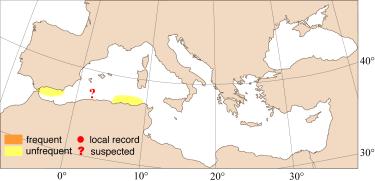|
SHORT
DESCRIPTION
Slender body. Snout long and round. Eyes large. Usually 15/15 rows of teeth, but may range from 14-16/13 -17. Upper teeth triangular and serrated, deeply notched close to the base. Lower teeth with smooth edges and sharp, narrow cusps. First dorsal fin origin behind the pectoral free rear tip. Second dorsal fin small, with a long inner margin; its origin slightly behind anal fin origin. Prominent ridge between dorsal fins. Pectoral fin long, narrow and falcate; its length 15-22% of total length.
color :
back grey to brown-grey, becoming white on the ventral surface and the lower caudal lobe.
size :
common 1.5 - 2.5 m (max. 3.3 m).
|
|
DISTINGUISHING CHARACTERISTICS
Carcharhinus brevipinna, C. limbatus, C. melanopterus: inter-dorsal ridge absent.
Carcharhinus altimus: the origin of first dorsal fin before free rear tip of pectoral fin.
Carcharhinus plumbeus: anterior nasal flaps usually low and inconspicuous. First dorsal very high (height about half predorsal space) and interdorsal ridge low.
Carcharhinus obscurus: the ventral line of first dorsal fin origin closer to pectoral fin rear tip than to pectoral insertion.
Rhizoprionodon acutus: origin of second dorsal fin behind origin of anal fin.
Galeocerdo cuvier: spiracle present, prominent lateral keels on caudal peduncle and coloration with vertical black or dusky bars on back.
Prionace glauca: papillose gillrakers present on gill arches, first dorsal fin midpoint equidistant or closer to pelvic fin origin than to axle of pectoral fin and coloration bright blue above, white below.
Squalidae: anal fin absent.
Lamnidae: caudal peduncle keeled laterally and caudal fin lunate.
Hexanchidae: dorsal fin single and six or seven pairs of gill-slits.
Triakidae: pre-caudal pits absent and upper edge of caudal fin with a straight margin.
BIOLOGY / ECOLOGY
Viviparous, embryos with placenta. Gestation period unknown. Two to fifteen pups per litter; size at birth: 70-87 cm. Males and females reach maturity at ca. 200 cm and ca. 220 cm, respectively. Feeds mainly on fish, but diet supplemented by cephalopods and pelagic crustaceans.
habitat :
oceanic, often enters coastal waters.
|

